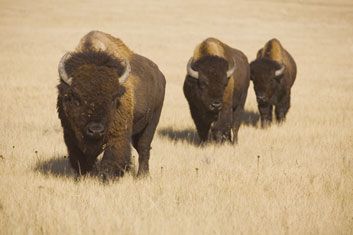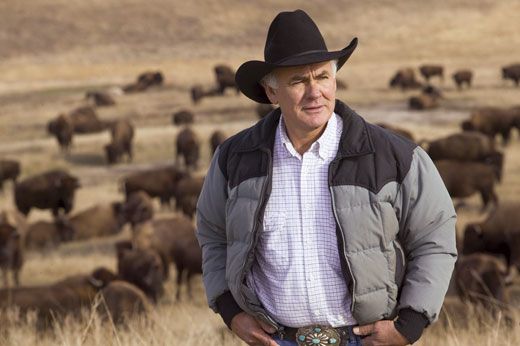Back Home On The Range
When a group of Native Americans took up bison ranching, they brought a prairie back to life
A bison's death "is now such an event that it is immediately chronicled by the Associated Press and telegraphed all over the country," conservationist William T. Hornaday wrote in 1889. Fifty years earlier, bison by the tens of millions had ranged across North America in herds so vast that observers compared them to roaring avalanches, grand armies and thunder. But even then, overhunting, loss of prairie habitat and diseases spread by domesticated cattle were ravaging the species. By the time Hornaday organized the American Bison Society in 1905, one of the nation's first environmental organizations, only a few hundred of the animals remained.
A century after the society began working to save the species from extinction, bison are an environmental success story. Numbers are up to around 400,000 across North America, mostly on private ranches. Now a new generation of advocates wants to restore the prairie habitat that bison once dominated. Some, including Plains Indians, whose tribes were almost wiped out along with the bison, also hope to restore a way of life the animal represented.
For centuries, many Great Plains tribes had depended almost entirely on bison (known commonly as buffalo, although they're not related to true buffalo species in Asia and Africa) for food, shelter, clothing and other needs. These Indians counted more than 100 uses for bison parts, from paintbrushes from fibrous hump bones to ladles from horns. According to the tribes' spiritual beliefs, bison sacrificed their lives to sustain the first people.
"We have to restore the buffalo if we are going to survive as a culture," says Fred DuBray, executive director of the InterTribal Bison Cooperative, in Rapid City, South Dakota, which he helped start in 1990 with five member tribes. Now 53 tribes in 18 states manage 15,000 head of bison.
DuBray's tribe, the Cheyenne River Sioux of north central South Dakota, occupies a 2,820,000-acre reservation that sprawls across two of the state's poorest counties. In the late 1990s, the tribal council purchased a 21,500-acre cattle ranch called the VE, which DuBray convinced the council to turn over to bison. He argued that bison would provide the reservation, where Type 2 diabetes is rife, with low-fat, low-cholesterol protein. But the glint in DuBray's piercing green eyes came from the idea of establishing a vast prairie park of native plants and animals.

Many scientists agree with DuBray that prairies and bison are inextricably linked. Historically, the animal's grazing and ranging habits helped determine which species populated the North American grassland. Replicating historical conditions, as some researchers and conservationists have tried to do, has been hard because most native prairie is long gone.
Though overgrazed when the Cheyenne River Sioux bought it, the VE Ranch boasted an abundance of hardy native plants—western wheatgrass, needle and thread, sagewort—and few of the exotic plants like leafy spurge that plague Plains ranches. The tribe took down internal fences, let the land rest for a three-year spell and released more than 2,000 bison onto its gently rolling hills in 2002.
Joanna Murray, a wildlife biologist, takes me in search of bison on the VE Ranch. As we veer off the old ranch road and start lurching cross-country, she cautions me not to think of these animals as cattle, which have been bred for docility for some 10,000 years. "Bison just roam freely," she calls out over the rattle of the pickup's suspension. They spend less time grazing than cattle do and, she adds, "they're rarely in one spot two days in a row."
As we drive slowly into a formidable herd, the muscular animals stand their ground. Moving only slightly to allow the pickup through, they form a loose circle and stare steadily at us. Around bison, you stay in your vehicle.
Traditionally, Native Americans would set fires to attract bison, which prefer to graze on burned areas where fresh grasses grow. A drought makes controlled burns risky. But even without fire, bison are furthering the VE Ranch's restoration. The animals rub their horns against saplings, stunting tree growth. They avoid broad-leaved plants, or forbs, which then thrive in grazed areas. Pronghorn antelopes eat the forbs bison leave behind. And bison wallows can hold rainwater for other wildlife.

In their quest to restore prairie habitat, the Cheyenne River Sioux are maintaining colonies of black-tailed prairie dogs, which cattle ranchers revile as a scourge that nibbles pasture to a nub and digs holes that hobble cattle. But more than 150 grassland species depend on prairie dog "towns." The burrowing owl makes its home in abandoned burrows. Rattlesnakes, swift fox, eagles and hawks prey on prairie dogs, as do black-footed ferrets, the plains' most endangered species. Working with the U.S. Fish and Wildlife Service, the tribe released dozens of ferrets onto its lands in 2000. Bison often gather around prairie dog towns. "Since the dogs constantly clip off grasses, there's always new growth, and it's very nutritious for the bison," Murray explains. Young bison grow faster when they graze in prairie dog towns.
Murray and I spy a herd of distant bison under a cornflower blue sky. A few pronghorn antelope stand motionless in the middle distance, poised to skitter away. Nearby, prairie dogs peer like sentries from atop their burrows, ready to sound an alarm as they watch a hawk wheel overhead.
Though the prairie is coming back on the VE Ranch, this venture remains a risky business. Prices for bison and bison meat have been unsteady. (Alone among South Dakota tribes, the Cheyenne River Sioux have forgone income from gambling.) The park won't earn much revenue from tourist admissions until a visitors' center is built, which will take years. And not everyone is pleased.
"On our reservation, it's not Democrats and Republicans, but traditionalists and progressives," says DuBray. Progressives, he says, loathe prairie dogs, believe livestock should be fenced, prefer cattle to bison, and are skeptical of establishing a tribal park to showcase prairie restoration. Traditionalists favor all of those things; DuBray says they are looking to the past for the shape of things to come.